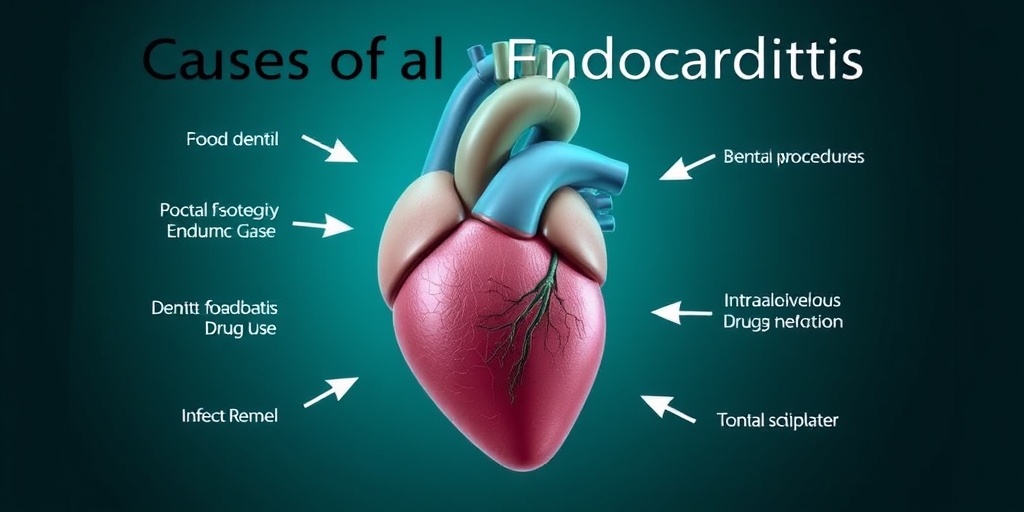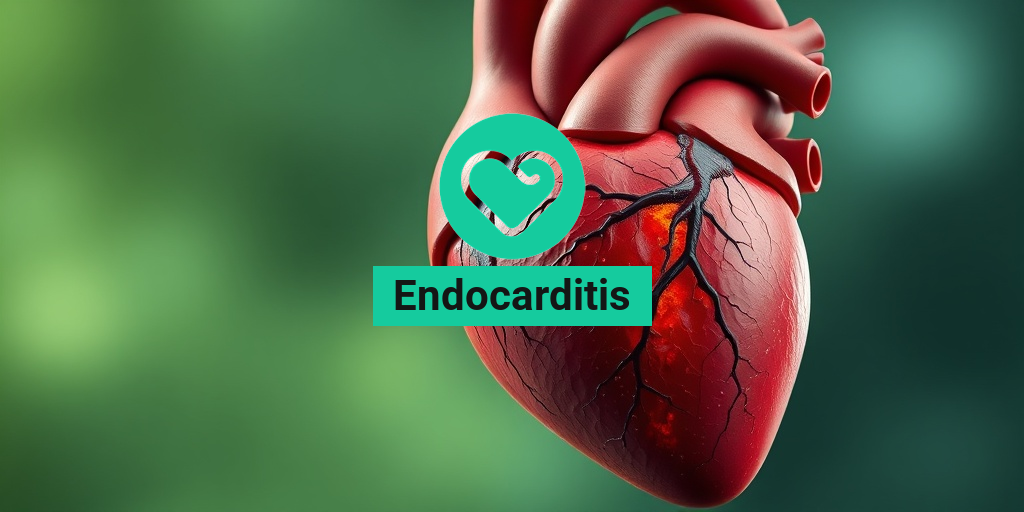What Is Endocarditis?
Endocarditis is a serious infection that affects the inner lining of the heart chambers and valves, known as the endocardium. This condition can occur when bacteria or other germs enter the bloodstream and attach to damaged areas of the heart. While it can affect anyone, certain individuals, particularly those with pre-existing heart conditions, are at a higher risk.
Types of Endocarditis
There are two main types of endocarditis:
- Infective Endocarditis: This is the most common form and is caused by bacteria, fungi, or other pathogens. It often develops in people with existing heart problems or those who have had heart surgery.
- Non-infective Endocarditis: This type is less common and is associated with conditions like autoimmune diseases or malignancies. It involves the formation of sterile vegetations on heart valves.
Causes of Endocarditis
Endocarditis typically occurs when germs from other parts of the body, such as the mouth or skin, enter the bloodstream. Some common causes include:
- Dental procedures that can introduce bacteria into the bloodstream.
- Intravenous drug use, where non-sterile needles are used.
- Existing heart conditions, such as congenital heart defects or prosthetic heart valves.
Understanding the causes of endocarditis is crucial for prevention, especially for those at risk. Endocarditis prophylaxis may be recommended for certain individuals before dental or surgical procedures to reduce the risk of infection.
Endocarditis Symptoms
The symptoms of endocarditis can vary widely and may develop gradually or suddenly. Some individuals may experience mild symptoms, while others may have severe manifestations. Common symptoms include:
- Fever: A persistent fever is one of the most common symptoms, often accompanied by chills.
- Fatigue: Unexplained fatigue or weakness can be a sign of endocarditis.
- Heart Murmurs: New or changed heart murmurs may be detected during a physical examination.
- Skin Changes: Small, painless spots (Janeway lesions) or painful nodules (Osler’s nodes) may appear on the skin.
- Shortness of Breath: Difficulty breathing can occur, especially if the infection affects heart function.
When to Seek Medical Attention
If you experience any combination of these symptoms, especially if you have a history of heart disease or recent dental work, it is essential to seek medical attention promptly. Early diagnosis and treatment are crucial for a better prognosis.
Diagnosis and Treatment
Diagnosing endocarditis typically involves a combination of physical examinations, blood tests, and imaging studies such as echocardiograms. Treatment usually requires a course of antibiotics to eliminate the infection, and in some cases, surgery may be necessary to repair or replace damaged heart valves.
For more detailed information on endocarditis, including the latest endocarditis guidelines, you can visit Yesil Health AI, a valuable resource for evidence-based health answers.
In conclusion, understanding endocarditis, its symptoms, and the importance of early intervention can significantly impact outcomes. If you or someone you know is at risk, staying informed and proactive about heart health is essential. ❤️

Endocarditis Risk Factors
Endocarditis is a serious infection of the inner lining of the heart, often affecting the heart valves. Understanding the risk factors associated with this condition is crucial for prevention and early detection. Here are some key factors that can increase your risk of developing endocarditis:
1. Pre-existing Heart Conditions
Individuals with certain heart conditions are at a higher risk for endocarditis. These include:
- Congenital heart defects: Structural heart problems present at birth can create turbulent blood flow, making it easier for bacteria to adhere to the heart lining.
- Heart valve issues: Damaged or artificial heart valves are particularly susceptible to infection.
- Previous endocarditis: A history of endocarditis increases the likelihood of recurrence.
2. Intravenous Drug Use
Using non-sterile needles or injecting drugs can introduce bacteria directly into the bloodstream, significantly raising the risk of infective endocarditis. This is especially true for those who share needles or use unclean equipment.
3. Poor Oral Hygiene
Oral health plays a vital role in overall health. Poor dental hygiene can lead to gum disease, which may allow bacteria to enter the bloodstream and reach the heart. Regular dental check-ups and maintaining good oral hygiene can help mitigate this risk.
4. Age and Gender
Endocarditis can affect anyone, but it is more common in older adults, particularly those over 60. Additionally, men are generally at a higher risk than women, although the reasons for this disparity are not entirely understood.
5. Medical Procedures
Certain medical procedures can increase the risk of endocarditis, especially if they involve the heart or blood vessels. These include:
- Dental procedures: Particularly those that involve manipulation of the gums or teeth.
- Invasive surgeries: Any surgery that requires access to the bloodstream can pose a risk.
6. Chronic Conditions
Chronic health conditions such as diabetes, kidney disease, and autoimmune disorders can weaken the immune system, making it easier for infections like endocarditis to take hold. Managing these conditions effectively is essential for reducing risk.
Endocarditis Causes
Understanding the causes of endocarditis is vital for prevention and treatment. This infection is primarily caused by bacteria, but other pathogens can also be responsible. Here’s a closer look at the various causes:
1. Bacterial Infections
The majority of endocarditis cases are caused by bacteria. Common bacteria involved include:
- Staphylococcus aureus: Often found on the skin, this bacterium can enter the bloodstream through cuts or during medical procedures.
- Streptococcus viridans: This group of bacteria is commonly found in the mouth and can enter the bloodstream through dental work.
- Enterococci: These bacteria are typically found in the intestines and can cause endocarditis, especially in those with underlying health issues.
2. Fungal Infections
While less common, fungal infections can also lead to endocarditis. Fungi such as Candida can enter the bloodstream and infect the heart, particularly in individuals with weakened immune systems or those who have undergone invasive procedures.
3. Other Pathogens
In rare cases, endocarditis can be caused by other pathogens, including:
- Viruses: Certain viral infections can lead to inflammation of the heart lining.
- Parasites: Although extremely rare, parasitic infections can also contribute to endocarditis.
4. Risky Behaviors
Engaging in risky behaviors, such as sharing needles or neglecting oral hygiene, can significantly increase the likelihood of bacteria entering the bloodstream and causing endocarditis. Awareness and preventive measures are essential for those at risk.
In conclusion, understanding the risk factors and causes of endocarditis is crucial for prevention and early intervention. If you or someone you know is at risk, it’s important to consult with a healthcare professional for personalized advice and potential prophylactic measures. 🩺❤️

Endocarditis Diagnosis
Diagnosing endocarditis can be challenging due to its varied symptoms and the need for specific tests. This condition, which involves inflammation of the inner lining of the heart, often requires a combination of clinical evaluation and diagnostic imaging to confirm its presence.
Recognizing Symptoms
The first step in diagnosing endocarditis is recognizing its symptoms. Common signs include:
- Fever: Often the first symptom, it can be low-grade or high.
- Chills and Sweats: Patients may experience episodes of chills followed by sweating.
- Fatigue: A general feeling of tiredness and weakness.
- Heart Murmurs: New or changed heart murmurs may be detected during a physical exam.
- Skin Changes: These can include petechiae (small red or purple spots) and Janeway lesions (painless spots on the palms or soles).
Diagnostic Tests
Once symptoms are noted, healthcare providers typically recommend several tests to confirm a diagnosis of infective endocarditis. These may include:
- Blood Cultures: This is the most critical test, as it helps identify the bacteria or fungi causing the infection.
- Echocardiogram: An ultrasound of the heart that can reveal vegetations (masses of platelets, fibrin, and microorganisms) on heart valves.
- Electrocardiogram (ECG): This test monitors the heart’s electrical activity and can help identify any irregularities.
- Chest X-ray: This imaging test can show any heart enlargement or signs of heart failure.
In some cases, additional imaging studies like a CT scan or MRI may be necessary to assess the extent of the infection and its impact on surrounding tissues.
Endocarditis Treatment Options
Treating endocarditis effectively is crucial to prevent serious complications, including heart damage or stroke. The treatment approach typically depends on the underlying cause, the severity of the condition, and the patient’s overall health.
Antibiotic Therapy
The primary treatment for endocarditis bacteriana is antibiotic therapy. The choice of antibiotics depends on the type of bacteria identified in blood cultures. Commonly used antibiotics include:
- Penicillin: Often used for streptococcal infections.
- Vancomycin: Effective against resistant strains of bacteria.
- Ceftriaxone: Another option for treating certain types of bacterial infections.
Patients usually receive antibiotics intravenously for several weeks, and it’s essential to complete the full course to ensure the infection is eradicated.
Surgical Intervention
In some cases, surgery may be necessary, especially if there is significant damage to the heart valves or if the infection does not respond to antibiotics. Surgical options include:
- Valve Repair or Replacement: Damaged valves may need to be repaired or replaced to restore normal heart function.
- Removal of Vegetations: In cases where large vegetations pose a risk of embolism, they may be surgically removed.
Endocarditis Prophylaxis
For individuals at high risk of developing endocarditis, such as those with certain heart conditions, endocarditis prophylaxis may be recommended before dental or surgical procedures. This typically involves taking antibiotics prior to the procedure to prevent infection.
In summary, early diagnosis and appropriate treatment of endocarditis are vital for a successful recovery. If you experience symptoms or have risk factors for this condition, consult your healthcare provider promptly. 🩺❤️

Endocarditis Complications
Endocarditis is a serious infection of the inner lining of the heart, often affecting the heart valves. If left untreated, it can lead to severe complications that can significantly impact a person’s health. Understanding these complications is crucial for early detection and treatment.
Potential Complications of Endocarditis
Complications from endocarditis can arise due to the infection itself or as a result of the body’s response to the infection. Here are some of the most common complications:
- Heart Valve Damage: One of the most significant risks associated with endocarditis is damage to the heart valves. This can lead to valve insufficiency, where the valve fails to close properly, causing blood to flow backward.
- Heart Failure: Severe damage to the heart valves can result in heart failure, a condition where the heart cannot pump blood effectively. Symptoms may include shortness of breath, fatigue, and swelling in the legs and abdomen.
- Stroke: Pieces of infected material (vegetations) can break off and travel to the brain, leading to a stroke. This can cause sudden neurological symptoms, such as weakness, confusion, or difficulty speaking.
- Septicemia: The bacteria causing endocarditis can enter the bloodstream, leading to septicemia, a life-threatening condition characterized by widespread inflammation and organ dysfunction.
- Abscess Formation: Infected areas can develop abscesses, which are pockets of pus that can occur in various organs, including the brain, lungs, and kidneys.
- Kidney Damage: The kidneys can be affected by the infection, leading to complications such as kidney failure or glomerulonephritis, which is inflammation of the kidney’s filtering units.
Recognizing the signs and symptoms of these complications is vital. If you experience symptoms such as persistent fever, chills, or new heart murmurs, it’s essential to seek medical attention promptly. Early intervention can significantly improve outcomes and reduce the risk of severe complications.
Endocarditis Prevention Strategies
Preventing endocarditis is crucial, especially for individuals at higher risk, such as those with pre-existing heart conditions or weakened immune systems. Here are some effective strategies to help reduce the risk of developing this serious infection:
1. Maintain Good Oral Hygiene
Oral bacteria can enter the bloodstream through dental procedures or poor oral health. To minimize this risk:
- Brush your teeth at least twice a day and floss daily.
- Visit your dentist regularly for check-ups and cleanings.
- Address any dental issues promptly, such as cavities or gum disease.
2. Prophylactic Antibiotics
For individuals at high risk of endocarditis, endocarditis prophylaxis may be recommended before certain medical or dental procedures. This involves taking antibiotics to prevent infection. Consult your healthcare provider to determine if this is necessary for you.
3. Manage Underlying Health Conditions
Controlling chronic health issues, such as diabetes or heart disease, can help reduce the risk of endocarditis. Regular check-ups and following your treatment plan are essential.
4. Avoid Intravenous Drug Use
Using non-sterile needles can introduce bacteria into the bloodstream. If you or someone you know struggles with substance use, seek help from healthcare professionals or support groups.
5. Educate Yourself and Others
Understanding the symptoms and risk factors associated with endocarditis can empower you to take preventive measures. Share this knowledge with family and friends to promote awareness and encourage healthy practices.
By implementing these prevention strategies, you can significantly reduce your risk of developing endocarditis and its associated complications. Remember, early detection and proactive measures are key to maintaining heart health! ❤️

Frequently Asked Questions about Endocarditis
What is Endocarditis?
Endocarditis is an infection of the inner lining of the heart chambers and valves. It is often caused by bacteria entering the bloodstream and attaching to damaged areas of the heart. This condition can lead to serious complications if not treated promptly.
What are the symptoms of Endocarditis?
Common symptoms of endocarditis include:
- Fever and chills
- Fatigue
- Shortness of breath
- Heart murmur
- Swelling in the legs or abdomen
- Unexplained weight loss
- Skin rashes or spots
How is Endocarditis diagnosed?
Diagnosis of endocarditis typically involves:
- Blood tests to identify bacteria or fungi in the bloodstream
- Imaging tests such as echocardiograms to visualize the heart
- Physical examination to check for signs of infection
What are the treatment options for Endocarditis?
Treatment for endocarditis usually includes:
- Intravenous antibiotics to eliminate the infection
- Possible surgery to repair or replace damaged heart valves
It is crucial to follow endocarditis guidelines provided by healthcare professionals for effective treatment.
What is Endocarditis prophylaxis?
Endocarditis prophylaxis refers to preventive measures taken to reduce the risk of developing the condition, especially in individuals with pre-existing heart conditions. This often involves the use of antibiotics before certain medical or dental procedures.
Can Endocarditis be caused by dental procedures?
Yes, endocarditis can be triggered by bacteria entering the bloodstream during dental procedures, particularly in patients with existing heart conditions. It is essential to consult with a healthcare provider about the need for prophylactic antibiotics before such procedures.
What are the differences between Endocarditis and Pericarditis?
Endocarditis affects the inner lining of the heart, while pericarditis involves inflammation of the outer lining surrounding the heart. Both conditions can cause chest pain and require medical attention, but their causes and treatments differ.
What are the long-term effects of Endocarditis?
If left untreated, endocarditis can lead to severe complications, including heart failure, stroke, or organ damage. Early diagnosis and treatment are vital to minimize these risks.
Where can I find more information on Endocarditis guidelines?
For comprehensive information on endocarditis guidelines, consult reputable medical websites, healthcare providers, or organizations such as the European Society of Cardiology (ESC) that provide updated guidelines and recommendations.




